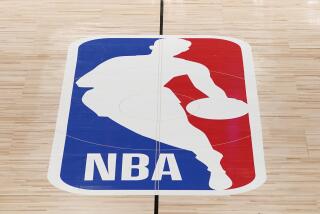AROUND HOME : The IBM Logo
- Share via
LOS ANGELES-BASED logo designer Paul Rand eschews sentimental, decorative styles in favor of uncluttered minimalism. The 75-year-old designer made news in 1986 for his NeXT computers logo--and his $100,000 design fee--which fatten a portfolio that also boasts hardy classics such as Westinghouse (1959), ABC (1962) and IBM (1956).
The IBM commission arose when company president Thomas J. Watson Jr. decided to revamp IBM along the lines of design-conscious competitor Olivetti, the Italian firm whose typewriters had been featured in a 1952 show at New York’s Museum of Modern Art. Called in to update IBM’s graphics, Rand opted not to try to depict IBM in a pictorial logo--a typewriter keyboard, say, or a zigzag lightning-bolt suggesting electricity. Instead, Rand decided to simplify IBM’s existing logo, comprising the letters I-B-M. His reasoning: An illustrative logo would be less flexible and adaptable for its countless applications (brochures, catalogues, letterheads, exhibition displays, packaging).
One package shows the amazing amount of mileage Rand could milk out of I-B-M: The letters’ bright primary colors, plus the identifying label Typewriter Ribbons that insouciantly snake across in ‘50s-style script, play off the solemn typeface of the logo, stacked three-high.
Still, Rand admitted to one qualm about the logo’s three letters: “Each character gets progressively wider, thereby creating a somewhat uncomfortable, open-ended sequence.” So he prepared an alternate version of the logo, dressed up with stripes to visually tie the letters together and attract attention. The stripes, he said, “take commonplace letters out of the realm of the ordinary. They are memorable. They suggest efficiency and speed.” Less, Rand’s logo proves, is more.
More to Read
The biggest entertainment stories
Get our big stories about Hollywood, film, television, music, arts, culture and more right in your inbox as soon as they publish.
You may occasionally receive promotional content from the Los Angeles Times.










